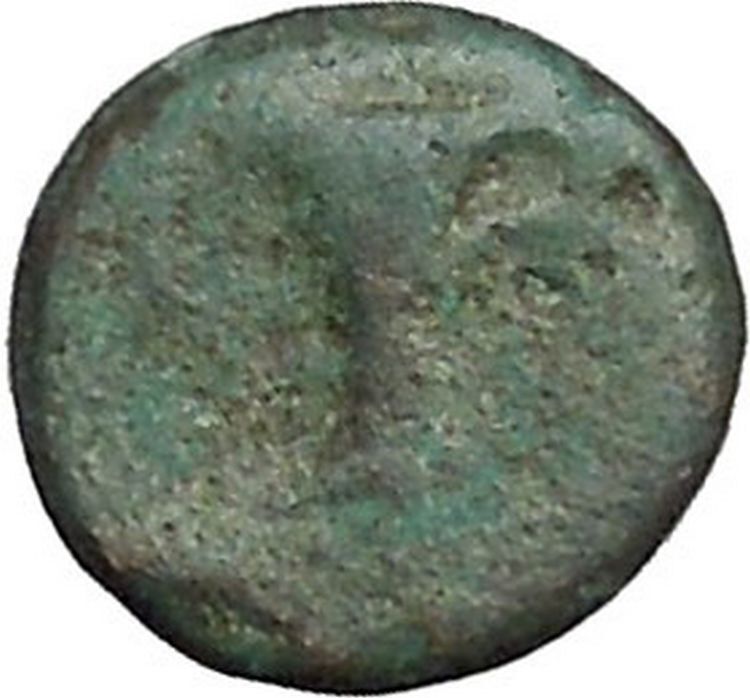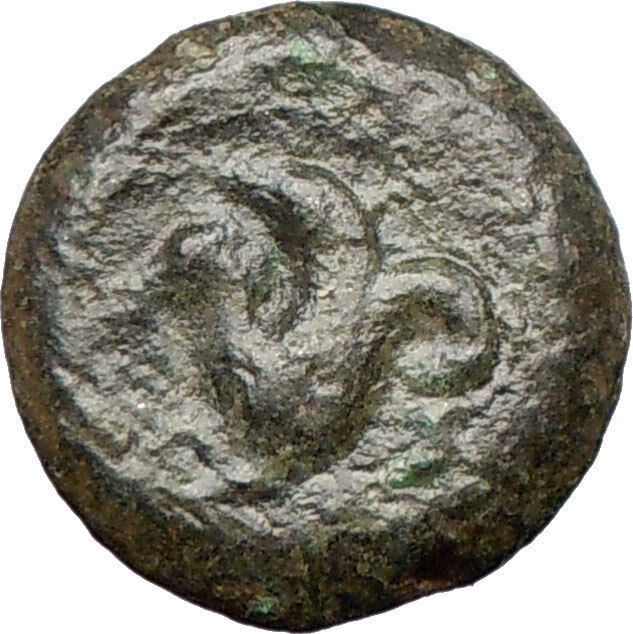|
GREEK City of Pella, Macedonia
Bronze 19mm (7.56 grams) Struck 158-149 B.C.
Reference: Sear 1446; Moushmov 6453; SNGCop 266ff.
Helmeted head of Athena Parthenos right
ΠEΛ-ΛHΣ, bull grazing right.
The city was founded by Archelaus I of Macedon (413–399 BC) as
the capital of his kingdom, replacing the older palace-city of Aigai (Vergina).
After this, it was the seat of King Philip II of Macedon and of Alexander the
Great, his son. In 168 BC, it was sacked by the Romans, and its treasury
transported to Rome. Later, the city was destroyed by an earthquake and
eventually was rebuilt over its ruins. By 180 AD, Lucian could describe it in
passing as “now insignificant, with very few inhabitants”.
You are bidding on the exact
item pictured, provided with a Certificate of Authenticity and Lifetime
Guarantee of Authenticity.
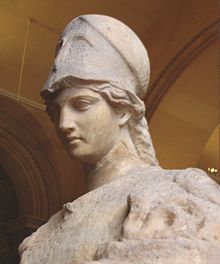
Helmeted Athena with the cista and Erichthonius in his serpent form.
Roman, first century (Louvre
Museum)
In
Greek religion
and
mythology
, Athena or Athene, also
referred to as Pallas Athena/Athene , is the goddess of wisdom, courage,
inspiration, civilization, law and justice, just warfare, mathematics, strength,
strategy, the arts, crafts, and skill.
Minerva
is the
Roman goddess
identified with
Athena.
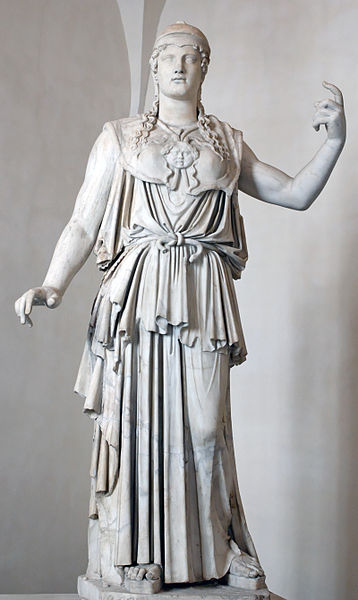
Athena is also a shrewd companion of
heroes and is the
goddess
of heroic endeavour. She is the
virgin
patroness of
Athens
. The Athenians founded the
Parthenon
on the Acropolis of her namesake
city, Athens (Athena Parthenos), in her honour.
Athena’s veneration as the patron of Athens seems to have existed from the
earliest times, and was so persistent that archaic myths about her were recast
to adapt to cultural changes. In her role as a protector of the city (polis),
many people throughout the Greek world worshiped Athena as Athena Polias
(Ἀθηνᾶ Πολιάς “Athena of the city”). The city of
Athens
and the goddess Athena essentially bear
the same name,
“Athenai” meaning “[many] Athenas”.
Patroness
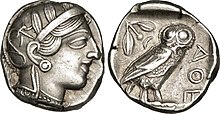
Athenian
tetradrachm
representing the
goddess Athena
Athena as the goddess of philosophy became an aspect of the cult in Classical
Greece during the late 5th century B.C. She is the patroness of various crafts, especially of
weaving
, as Athena Ergane, and was
honored as such at festivals such as
Chalceia
. The metalwork of weapons also fell
under her patronage. She led battles (Athena
Promachos or the warrior maiden Athena Parthenos)
as the disciplined, strategic side of war, in contrast to her brother
Ares, the patron of violence, bloodlust and slaughter—”the raw force
of war”.
Athena’s wisdom includes the cunning intelligence (metis) of such figures
as Odysseus
. Not only was this version of Athena
the opposite of Ares in combat, it was also the polar opposite of the serene
earth goddess version of the deity, Athena Polias.
Athena appears in Greek mythology as the patron and helper of many heroes,
including Odysseus
,
Jason
, and
Heracles
. In
Classical Greek
myths, she never consorts with
a lover, nor does she ever marry,earning the title Athena Parthenos. A remnant of archaic myth depicts her
as the adoptive mother of
Erechtheus
/Erichthonius
through the foiled rape by
Hephaestus
.
Other variants relate that Erichthonius, the serpent that accompanied Athena,
was born to
Gaia
: when the rape failed, the semen landed on
Gaia and impregnated her. After Erechthonius was born, Gaia gave him to Athena.
Though Athena is a goddess of war strategy, she disliked fighting
without
purpose and preferred to use wisdom to settle predicaments.The goddess
only encouraged fighting for a reasonable cause or to resolve
conflict. As patron of Athens she fought in the Trojan war on the side
of the
Achaeans.
Mythology
Lady of Athens
Athena competed with
Poseidon
to be the patron deity of Athens,
which was yet unnamed, in a version of one
founding myth
. They agreed that each would give
the Athenians one gift and that the Athenians would choose the gift they
preferred. Poseidon struck the ground with his
trident
and a salt water spring sprang up; this
gave them a means of trade and water—Athens at its height was a significant sea
power, defeating the
Persian
fleet at the
Battle of Salamis
—but the water was salty and
not very good for drinking.
Athena, however, offered them the first domesticated
olive tree
. The Athenians (or their king,
Cecrops
) accepted the olive tree and with it
the patronage of Athena, for the olive tree brought wood, oil, and food.
Robert Graves
was of the opinion that
“Poseidon’s attempts to take possession of certain cities are political myths”
which reflect the conflict between matriarchal and patriarchal religions.
Other sites of cult
Athena also was the patron goddess of several other Greek cities, notably
Sparta, where the archaic cult of
Athena Alea
had its sanctuaries in the
surrounding villages of
Mantineia
and, notably,
Tegea
. In Sparta itself, the temple of Athena
Khalkíoikos (Athena “of the Brazen House”, often
latinized
as Chalcioecus) was the
grandest and located on the Spartan acropolis; presumably it had a roof of
bronze. The forecourt of the Brazen House was the place where the most solemn
religious functions in Sparta took place.
Tegea was an important religious center of ancient Greece,
containing the Temple of
Athena Alea
. The temenos was founded by
Aleus
,
Pausanias
was informed.
Votive bronzes at the site from the Geometric and Archaic periods take the forms
of horses and deer; there are
sealstone
and
fibulae
. In the Archaic period the nine
villages that underlie Tegea banded together in a
synoecism
to form one city.
Tegea was listed in Homer
‘s
Catalogue of Ships
as one of the cities that
contributed ships and men for the
Achaean assault on Troy
.
Judgment of Paris

Aphrodite is being surveyed by Paris, while Athena (the leftmost
figure) and Hera stand nearby.
El Juicio de Paris
by
Enrique Simonet
, ca. 1904
All the gods and goddesses as well as various mortals were invited to the
marriage of Peleus
and
Thetis
(the eventual parents of
Achilles
). Only
Eris
, goddess of discord, was not invited. She
was annoyed at this, so she arrived with a golden apple inscribed with the word
καλλίστῃ (kallistēi, “for the fairest”), which she threw among the goddesses.
Aphrodite, Hera, and Athena all claimed to be the fairest, and thus the rightful
owner of the apple.
The goddesses chose to place the matter before Zeus, who, not wanting to
favor one of the goddesses, put the choice into the hands of Paris, a
Trojan prince. After bathing in the spring of
Mount Ida
(where Troy was situated), the
goddesses appeared before Paris. The goddesses undressed and presented
themselves to Paris naked, either at his request or for the sake of winning.

Paris is awarding the apple to Aphrodite, while Athena makes a face.
Urteil des Paris by
Anton Raphael Mengs
, ca. 1757
Still, Paris could not decide, as all three were ideally beautiful, so they
resorted to bribes. Hera tried to bribe Paris with control over all
Asia and Europe
, while Athena offered wisdom, fame and
glory in battle, but Aphrodite came forth and whispered to Paris that if he were
to choose her as the fairest he would have the most beautiful mortal woman in
the world as a wife, and he accordingly chose her. This woman was
Helen
, who was, unfortunately for Paris,
already married to King
Menelaus
of
Sparta
. The other two goddesses were enraged by
this and through Helen’s abduction by Paris they brought about the
Trojan War
.

The Parthenon
, Temple of Athena
Parthenos
Masculinity and
feminism
Athena had an “androgynous compromise” that allowed her traits and what she
stood for to be attributed to male and female rulers alike over the course of
history (such as Marie de’ Medici, Anne of Austria, Christina of Sweden, and
Catherine the Great)
J.J. Bachofen advocated that Athena was originally a maternal figure stable
in her security and poise but was caught up and perverted by a patriarchal
society; this was especially the case in Athens. The goddess adapted but could
very easily be seen as a god. He viewed it as “motherless paternity in the place
of fatherless maternity” where once altered, Athena’s character was to be
crystallized as that of a patriarch.
Whereas Bachofen saw the switch to paternity on Athena’s behalf as an
increase of power, Freud on the contrary perceived Athena as an “original mother
goddess divested of her power”. In this interpretation, Athena was demoted to be
only Zeus’s daughter, never allowed the expression of motherhood. Still more
different from Bachofen’s perspective is the lack of role permanency in Freud’s
view: Freud held that time and differing cultures would mold Athena to stand for
what was necessary to them.
Pella (Greek:
Πέλλα), an ancient city located in
Pella Prefecture
of
Macedonia
in Greece
, was the
capital
of the
ancient
kingdom
of
Macedon
. A common
folk etymology
is traditionally given for the name Pella, ascribing
it to a form akin to the
Doric
Apella
,
originally meaning a ceremonial location where decisions were made.[1]
However, the local form of Greek was not Doric, and the word exactly matches
standard Greek pélla “stone”, undoubtedly referring to a famous landmark
from the time of its foundation.[2]
//
History
The city was founded by
Archelaus
(413–399
BC) as the capital of his kingdom, replacing the older palace-city of
Aigai
(Vergina).
After this, it was the seat of the king
Philip II
and of
Alexander
, his son. In
168 BC
, it was
sacked by the
Romans
,
and its treasury transported to
Rome. Later, the
city was destroyed by an
earthquake
and eventually was rebuilt over its ruins. By 180 AD,
Lucian
could
describe it in passing as “now insignificant, with very few inhabitants”.
Pella is first mentioned by
Herodotus
of
Halicarnassus
(VII, 123) in relation to
Xerxes
‘ campaign and by
Thucydides
(II, 99,4 and 100,4) in relation to Macedonian expansion and the war against
Sitalces
,
the king of the Thracians
. According to
Xenophon
,
in the beginning of the 4th century BC, it was the largest Macedonian city. It
was probably built as the capital of the kingdom by Archelaus, although there
appears to be some possibility that it may have been
Amyntas
. It attracted Greek artists such the painter
Zeuxis
, the poet
Timotheus
of
Miletus
and the
tragic author
Euripides
who finishes his days there writing and producing Archelaus.
Archelaus invited the painter
Zeuxis
, the
greatest painter of the time, to decorate it. He was later the host of the
Athenian playwright
Euripides
in his retirement. Euripides
Bacchae
premiered here, about
408 BC
. Pella
was the birthplace of Philip II and of Alexander, his son. The hilltop
palace
of
Philip, where Aristotle
tutored young Alexander, is being excavated.
In antiquity, Pella was a port connected to the
Thermaic Gulf
by a navigable
inlet
, but the
harbor has silted, leaving the site landlocked. The reign of
Antigonus
likely represented the height of the city, as this is the period
which has left us the most archaeological remains.
Pella is further mentioned by
Polybius
and Livy
as the
capital of
Philip V
and of
Perseus
during the
Macedonian Wars
, fought against the
Roman Republic
. In the writings of Livy, we find the only description of how
the city looked in 167 BC
to
Lucius Aemilius Paulus Macedonicus
, the Roman who defeated Perseus at the
battle
of Pydna
:
- …[Paulus] observed that it was not without good reason that it had been
chosen as the royal residence. It is situated on the south-west slope of a
hill and surrounded by a marsh too deep to be crossed on foot either in
summer or winter. The citadel the “Phacus,” which is close to the city,
stands in the marsh itself, projecting like an island, and is built on a
huge substructure which is strong enough to carry a wall and prevent any
damage from the infiltration from the water of the lagoon. At a distance it
appears to be continuous with the city wall, but it is really separated by a
channel which flows between the two walls and is connected with the city by
a bridge. Thus it cuts off all means of access from an external foe, and if
the king shut anyone up there, there could be no possibility of escape
except by the bridge, which could be very easily guarded..[3]
The famous poet Aratus
died in Pella ca
240 BC
. Pella
was sacked by the Romans in
168 BC
, when
its treasury was transported to Rome.
In the
Roman province of Macedonia
, Pella was the capital of the third district,
and was possibly the seat of the Roman governor. Crossed by the
Via
Egnatia
[4],
Pella remained a significant point on the route between
Dyrrachium
and
Thessalonika
. Cicero
stayed there in
58 BC
, but by
then the provincial seat had already transferred to Thessalonika. It was then
destroyed by earthquake in the first century BC; shops and workshops dating from
the catastrophe have been found with remains of their merchandise. The city was
eventually rebuilt over its ruins, which preserved them, but, ca
AD 180
,
Lucian
of Samosata
could describe it in passing as “now insignificant, with very few
inhabitants”
[5]
The city went into decline for reasons unknown (possibly an earthquake) by
the end of the 1st century BC. It was the object of a colonial deduction
sometime between 45 and
30 BC
; in any
case currency was marked Colonia Iulia Augusta Pella.
Augustus
settled peasants there whose land he had usurped to give to his veterans (Dio
Cassius LI, 4). But unlike other Macedonian colonies such as
Philippi
,
Dion
, and
Cassandreia
it never came under the jurisdiction of
ius
Italicum
or Roman law. Four pairs of colonial magistrates (IIvirs
quinquennales) are known for this period.
The decline of the city was rapid, in spite of colonization:
Dio
Chrysostom
( 33.27Or.)
and Lucian
both
attest to the ruin of the ancient capital of Philip II and Alexander; though
their accounts may be exaggerated. In fact, the Roman city was somewhat to the
west of and distinct from the original capital; which explains some
contradictions between coinage,
epigraphs
, and testimonial accounts. In the Byzantine period, the Roman site
was occupied by a fortified village.
The
site
Urban
area
The city is built on the
island
of Phacos
, a
promontory
which dominates the wetlands which encircle Pella to the south, and a lake which
opened to the sea in the
Hellenistic period
.
Palace
The city wall mentioned by Livy is only partly known. It consists of a
rampart of crude bricks (about 50 cm square) raised on a stone foundation; some
of which has been located North of the palace, and some in the South next to the
lake. Inside the ramparts, three hills occupy the North, and the palace is
situated on a place of honour on the central hill. Partly searched, it occupied
a considerable area of perhaps 60,000 square metres). The plan is still not well
known, but has been related to that of the city plan (see diagram).
The Pella palace consisted of several — possibly seven — large architectural
groupings juxtaposed in two rows, each including a series of rooms arranged
around a central square courtyard, generally with porticos. Archaeologists have
thus far identified a
palaestra
and baths
. The south facade of the palace, towards the city, consisted of one
large (at least 153 metres long) portico, constructed on a two metres high
foundation. The relationship between the four principal complexes is defined by
an interruption in the portico occuupied by a triple
propylaeum
, 15 m high, which gave the palace an imposing monumental air when
seen from the city below.
Dating of the palace has posed some problems: the large buildings could date
the reign of Philip II, but other buildings appear to be earlier. The baths date
from the reign of
Cassander
.
The size of the complex indicates that, unlike the palace at Vergina, this
was not only a royal residence or a grandiose monument but also a place of
government which was required to accommodate a portion of the administrative
apparatus of the kingdom.
Hippodamean
plan
The city proper was located south of and below the palace. Designed on a
grid plan
as envisaged by
Hippodamus
, it consists of two series of parallel streets which intersect at
right angles and form a grid of eight rows of rectangular blocks. These blocks
are of a consistent width — each approximately 45 m — and a length which varies
from 111 m to 152 m, 125 metres being the most common. The streets are from 9 to
10 metres wide, except for the middle East–West arterial, which is up to 15
metres wide. This street is the primary access to the central public
agora
, which
occupied a space of ten blocks. Two North-South streets area also a bit wider
than the rest, and serve to connect the city to the port further South. The
streets had sewers and were equipped to convey water to individual residences.

Lion Hunt Mosaic in Pella
This type of plan dates to the first half of the fourth century BC, and is
very close to the ideal in design, though it distinguishes itself by large block
size; Olynthus
in
Chalcidice
for example had blocks of 86.3×35 metres. On the other hand,
later Hellenistic urban foundations have blocks comparable to those of Pella:
112×58 m in Laodicea ad Mare
, or 120×46 m in
Aleppo
.
The agora holds pride of place in the centre of the city, occupying an
imposing 200 by 181 metres; 262×238 metres if one counts the potrticos which
surround it on all sides.
Archaeology
Based on the descriptions provided by
Titus Livius
, the site was explored by 19th-century voyagers including
Holand, Pouqueville, Beaujour, Cousinéry, Delacoulonche, Hahn, Glotz and Struck.
The first excavation was begun by G. Oikonomos in 1914–15. The modern systematic
exploration of the site began in 1953 and full excavation was being done in
1957. The first series of campaigns were completed in 1963, more excavations
following in 1980. These digs continue in the section identified as the agora.
In February 2006, a farmer accidentally uncovered the largest tomb ever found
in Greece. The names of the noble
ancient Macedonian
family are still on inscriptions and painted sculptures
and walls have survived. The tomb dates to the
2nd
or 3rd century BC, following the rule of Alexander the Great.[6]
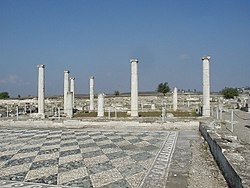
An atrium with a pebble-mosaic paving
Archaeological digs in progress since 1957 have uncovered a small part of the
city, which was made rich by Alexander and his heirs. The large agora or market
was surrounded by the shaded colonnades of
stoae, and streets
of enclosed houses with frescoed walls round inner courtyards. The first
trompe-l’oeil
wall murals imitating perspective views ever seen were on
walls at Pella. There are
temples
to Aphrodite
,
Demeter
and
Cybele
, and
Pella’s pebble-mosaic floors, dating after the lifetime of Alexander, are
famous: some reproduce Greek paintings; one shows a lion-griffin attacking a
stag, a familiar motif also of
Scythian
art, another depicts
Dionysus
riding a leopard.
|













